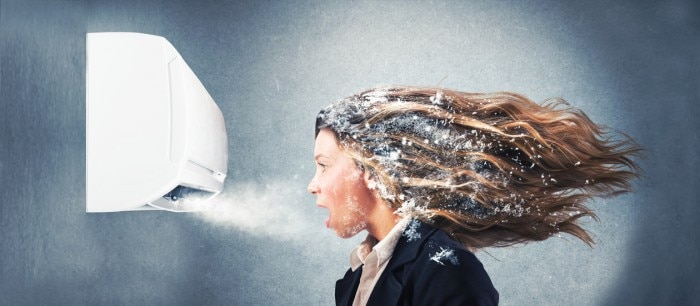MENÜ
AT | EUR
AT | EUR
-
- Tischzentrifugen
- Standzentrifugen
- Gekühlte Zentrifugen
- Mikrozentrifugen
- Mehrzweckzentrifugen
- Hochgeschwindigkeitszentrifugen
- Ultrazentrifugen
- Concentrator
- IVD Produkte
- High-Speed and Ultracentrifuge Consumables
- Zentrifugenröhrchen
- Zentrifugenplatten
- Gerätemanagement
- Proben- und Informationsmanagement
Es konnten keine Ergebnisse gefunden werden.
Such-Empfehlungen

Air or Water?
Lab Academy
- Molecular Biology
- Storage
- Freezers & Accessories
- Essay
Reliable -80°C are generated by passive support (i.e. insulation or gaskets) as well as by active cooling via the compressors. The compressors are literally the core of every freezer. When generating cold, especially super-cold like -80°C, the compressors (or any similar machines) create heat. The cooling liquid (gas) is compressed within the compressor, the compressed gas becomes hot. You might know this process when you use a bicycle tire inflator and block the exit valve with your finger while pumping. The compressed, hot cooling gas is transferred to the condenser where the heat is removed from the cooling gas which becomes liquid.
In general, there are two ways to remove the heat from the condenser.
The classic air-cooling of ULT freezers is performed by a fan at the compressor compartment. The fan actively absorbs cooler air from the environment and blows it towards the condenser. Hereby, the heat is blown out of the compressor compartment into the lab environment. The principle is simple and reliable. Unfavorable, the air around the ULT freezer is warming up. Especially when several freezers are located in the same room, the room temperature in this room substantially rises.
The temperature rise must be controlled by air ventilation (open window) or by active air cooling (e.g. HVAC). Otherwise, the temperature will reach a critical point where the cooling system of the ULT freezers may break down due to over-heating. As a final result, the ten thousands of high-value samples will defrost and get lost.
For some years now, an alternative method for the freezer cooling is getting more and more attention: Water-cooling.
For this special type of cooling, some adaptions at the freezer are mandatory:
The ULT freezer has an inlet water port and an outlet water port. The condenser is equipped with a heat exchanger. A constant flow of cool water at this heat exchanger takes the heat away.
In contrast to air-cooling, the water-cooled freezer has a lower heat output towards the lab environment.
The first water-cooled freezers were using flow water without recirculation. As the cooling needs ca. 250 cubic meter of fresh water per year and freezer, the non-circulating system is not recommended due to high costs for water as well as the negative sustainability factor.
More and more new buildings are designed with cooling water circulation systems. The warmed-up cooling water from the ULT freezer is directed to a heat exchanger which can be part of the central building heating system. This heat exchanger extracts the heat from the freezer cooling water to support the building heating system. When leaving the heat exchanger, the freezer cooling water is cooled down to be re-used at the ULT freezer.
This circulation process saves resources as well as money by supporting the local building heating system.
When a new building is designed from scratch including cooling water circulation systems, the air condition systems (HVAC) in those rooms where ULT freezers are planned to be located, can have a reduced dimension.
The classic air-cooling of ULT freezers is performed by a fan at the compressor compartment. The fan actively absorbs cooler air from the environment and blows it towards the condenser. Hereby, the heat is blown out of the compressor compartment into the lab environment. The principle is simple and reliable. Unfavorable, the air around the ULT freezer is warming up. Especially when several freezers are located in the same room, the room temperature in this room substantially rises.
The temperature rise must be controlled by air ventilation (open window) or by active air cooling (e.g. HVAC). Otherwise, the temperature will reach a critical point where the cooling system of the ULT freezers may break down due to over-heating. As a final result, the ten thousands of high-value samples will defrost and get lost.
For some years now, an alternative method for the freezer cooling is getting more and more attention: Water-cooling.
For this special type of cooling, some adaptions at the freezer are mandatory:
The ULT freezer has an inlet water port and an outlet water port. The condenser is equipped with a heat exchanger. A constant flow of cool water at this heat exchanger takes the heat away.
In contrast to air-cooling, the water-cooled freezer has a lower heat output towards the lab environment.
The first water-cooled freezers were using flow water without recirculation. As the cooling needs ca. 250 cubic meter of fresh water per year and freezer, the non-circulating system is not recommended due to high costs for water as well as the negative sustainability factor.
More and more new buildings are designed with cooling water circulation systems. The warmed-up cooling water from the ULT freezer is directed to a heat exchanger which can be part of the central building heating system. This heat exchanger extracts the heat from the freezer cooling water to support the building heating system. When leaving the heat exchanger, the freezer cooling water is cooled down to be re-used at the ULT freezer.
This circulation process saves resources as well as money by supporting the local building heating system.
When a new building is designed from scratch including cooling water circulation systems, the air condition systems (HVAC) in those rooms where ULT freezers are planned to be located, can have a reduced dimension.
Mehr erfahren
Weniger lesen

